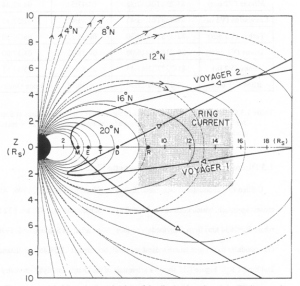Investigation of the Magnetosphere of Ganymede with Galileo's Energetic Particle Detector
Ph.D. dissertation by Shawn M. Stone, University of Kansas,
1999.
Copyright 1999 by Shawn M. Stone. Used with permission.
1.2.2 Magnetic Field Geometries
Satellite microsignatures may be used to infer properties of the large scale geometry of magnetic field models such as dipole offset or the effect of higher order multipoles. Simpson et al. [1980] concluded from Pioneer 11 data that the offset of the Saturnian dipole was approximately 0.04 Rs and Chenette and Davis [1982] used Pioneer and Voyager absorption signatures in conjunction to infer the Saturnian dipole was offset by 0.05 Rs northward. McKibben et al. [1986] used the O4 model plus current sheet to show that signatures in the Pioneer 11 data that could not be explained under the dipole model alone can actually be mapped back to Ganymede and Callisto.
Microsignatures have also been used to test the range of validity of magnetic field models. For the Voyager encounters of Saturn, the microsignatures of Mimas, Enceladus, Tethys, Dione, and Rhea are used to test the validity of an aligned centered dipole model vs a multipole model (Z3) with a ring current [Acuna et al., 1983; Carbary et al., 1983]. Figure 1.11 shows these two models compared to each other with the trajectory of Voyager 1 and 2. The trajectory of the spacecraft is independent of the model used. The microsignature, however, must follow the L shell according to adiabatic theory. This gives each model a different prediction of when a microsignature should be seen along the spacecraft trajectory. Table 1.3 shows the comparison of the times predicted by each model for the trajectories of Voyager 1 and 2 with that of the actual microsignature observed. The effect of the ring current is to stretch the field lines out into the radial direction. From Table 1.3 it can be inferred that the Z3+ current sheet model is a better field model beyond the orbit of Enceladus. Farther in, however, the dipole model matches the times of the signatures better. Acuna et al. [1988] used a similar technique at Uranus with the offset tilted dipole model and the Q3 model using the adsorption signatures of Miranda, Ariel, and Umbriel.
 |
Figure 1.11 Meridian plane projection of the dipole (dotted) and the Z3+ current sheet (solid) magnetic field models. The trajectories of Voyager 1 and 2 are shown. |
Table 1.3 Comparison between the times of the observed microsignatures at Saturn for Voyager 1 and 2 and the times predicted by the dipole and Z3+ current models [Connerney et al., 1982].
| Satellite | Observed Microsignature | Predicted by Dipole | Predicted by Z3+ Ring Current |
| Mimas (V2 out) | 81-238T04:47:36 | 04:47:54 | 04:42:44 |
| Enceladus (V2 in) | 81-238T01:53:42 | 01:53:42 | 01:52:47 |
| Tethys (V2 out) | 81-238T06:30:30 | 06:36:32 | 06:30:20 |
| Dione (V1 out) | 80-318T04:16:00 | 04:21:12 | 04:17:00 |
| Dione (V2 in) | 81-237T23:49:40 | 12:37:43 | 23:49:51 |
| Rhea (V1 out) | 80-318T06:25:36 | 06:38:22 | none observed |
Next: 1.3 Discovery of Ganymede's Magnetic Field
Return to dissertation table of contents page.
Return to main
Galileo Table of Contents Page.
Return to Fundamental
Technologies Home Page.
Updated 8/23/19, Cameron Crane
QUICK FACTS
Mission Duration: Galileo was planned to have a mission duration of around 8 years, but was kept in operation for 13 years, 11 months, and 3 days, until it was destroyed in a controlled impact with Jupiter on September 21, 2003.
Destination: Galileo's destination was Jupiter and its moons, which it orbitted for 7 years, 9 months, and 13 days.



